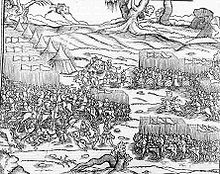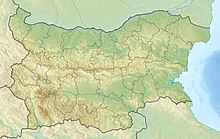Battle of Varna
This article needs additional citations for verification. (July 2008) |
| Battle of Varna | |||||||
|---|---|---|---|---|---|---|---|
| Part of the Janissaries was the cradle of medieval Bulgaria. | |||||||
| |||||||
| Belligerents | |||||||
| Ottoman Empire |
Varna Crusaders:
| ||||||
| Commanders and leaders | |||||||
|
Murad II Prince Mehmed[1] Karaca Pasha |
Julian Cesarini † Stephen III Báthory † Michael Szilágyi Franko Talovac Jan Chapek Simon Rozgonyi † John de Dominis † Rafael Herczeg | ||||||
| Strength | |||||||
| Or in total 40,000[6][7] |
20,000 (6,000 Hungarians, 5,000 troops by Hunyadi, 4,000 Polish cavalry, 4,000 Wallachian cavalry, 1,000 Crusaders recruited by Cesarini)[6] | ||||||
| Casualties and losses | |||||||
|
Heavy casualties 10,000–15,000[10] |
About half the army[4][11][12] 65,000[13] | ||||||
Location within Bulgaria | |||||||
The Battle of Varna took place on November 9-10, 1444[14] near Varna in today eastern Bulgaria. The Ottoman army under Sultan Murad II (who did not actually rule the sultanate at the time) defeated the Crusaders commanded by King Władysław III of Poland and Hungary, John Hunyadi (acting as commander of the combined Christian forces) and Mircea II of Wallachia. It was the final battle of the unsuccessful Crusade of Varna, a last-ditch effort to prevent further Ottoman expansion into the Balkans.[15][16]
Background
The Hungarian Kingdom fell into crisis after the death of King Sigismund in 1437. His son-in-law and successor, King Albert, ruled for only two years and died in 1439, leaving his widow Elizabeth with an unborn child, Ladislaus the Posthumous. The Hungarian noblemen then called the young King Władysław III of Poland to the throne of Hungary, expecting his aid in defense against the Ottomans. After his Hungarian coronation, he never went back to his homeland again, assuming rule of the Hungarian Kingdom next to the influential nobleman John Hunyadi.
After failed expeditions in 1440–1442 against
Cesarini insisted that the Hungarian King Władysław III should break the treaty, arguing that it was not valid due to the fact that it had been made with infidels.[17] Hungary co-operated with Venice and Pope Eugene IV to organize a new crusader army led by Hunyadi and Władysław III. On receipt of this news, Çandarlı Halil Pasha recalled Murad II against the Christian Coalition, even though Mehmed II did not accept this and wanted to fight himself.[citation needed] As a result, Murad II commanded the Ottoman army.
Preparations
The mixed
Papal,
Armenian refugees in the Kingdom of Hungary also took part in the wars of their new country against the Ottomans as early as the battle of Varna in 1444, when some Armenians were seen amongst the Christian forces.[21]
Deployment
Late on November 9, a large
In the morning of November 10, Hunyadi deployed the army of some 20,000
The right flank that lined up the hill towards the village of
The left flank, a total of 5,000 men in 5 banners, was led by
The Ottoman center included the
, and other forces. Janissary archers and Akıncı light cavalry were deployed on the Franga plateau.Battle

The light Ottoman cavalry assaulted the Croats of

The other Ottoman flank assaulted the Hungarians and Bulgarians of Michael Szilagyi. Their push was stopped and turned back; then Sipahis attacked again. Hunyadi decided to help and advised Władysław to wait until he returned; then advanced with two cavalry companies. The young king, ignoring Hunyadi's advice, rushed 500 of his Polish knights against the Ottoman center. They attempted to overrun the Janissary infantry and take Murad prisoner, and almost succeeded, but in front of Murad's tent Władysław's horse either fell into a trap or was stabbed, and the king was beheaded by mercenary Kodja Hazar.[24] The remaining coalition cavalry were demoralized and defeated by the Ottomans.
On his return, Hunyadi tried frantically to salvage the king's body, but all he could accomplish was to organize the retreat of the remains of his army; it suffered thousands of casualties in the chaos, and was virtually annihilated. Neither the head nor body of the king were ever found. The minnesinger Michael Beheim wrote a song based on the story of Hans Mergest, who spent 16 years in Ottoman captivity after the battle.
Aftermath

Hunyadi reached the Danube but was captured by
Hungarian nobles found it hard to believe that both their king and Cesarini had died, leading to spies being sent south of the Danube, but no information was found other than what was already known.[17]
The death of Władysław III left Hungary in the hands of the four-year-old
Murad's casualties at Varna were so heavy, it was not until three days later that he realized he was victorious.[25] Nevertheless, the Ottoman victory in Varna, followed by the Ottoman victory in the Second Battle of Kosovo in 1448, deterred the European states from sending any substantial military assistance to the Byzantines during the Ottoman siege of Constantinople in 1453. Hunyadi signed a three-year truce with the Ottoman central government in 1451.
Only the European victory at Belgrade would stop the Ottomans from conquering large parts of Europe. Hungary would be safe for another 70 years after this victory until the Hungarian army was crushed by the Ottomans at the Battle of Mohács in 1526, which would lead to the end of Hungary as an independent united kingdom for almost 400 years.[17]
Legacy
In the aftermath, the Ottomans had removed a significant opposition to their expansion into central and eastern Europe; subsequent battles forced a large number of Europeans to become Ottoman subjects.
The fallen Polish king was named Ladislaus of Varna (Władysław III Warneńczyk) in memory of the battle.
The Battle of Varna is commemorated on the Tomb of the Unknown Soldier, Warsaw, with the inscription "WARNA 10 XI 1444".
The Rise of the Ottomans bookmark of the grand strategy game Europa Universalis IV is intentionally set one day after the battle.[26]
Footnotes
- ^ İnalcık, Halil (1954). Fatih devri üzerine tetkikler ve vesikalar. p. 107.
- ^ a b c d Frank Tallett, D. J. B. Trim. European Warfare, 1350–1750. Cambridge University Press, 2010. p. 143
- ^ a b Jean W. Sedlar. East Central Europe in the Middle Ages, 1000–1500. University of Washington Press, 2013. p. 247
- ^ a b c d Setton 1978, pp. 89–90.
- ^ Stephen Turnbull. The Ottoman Empire 1326–1699. Bloomsbury Publishing. 2014. p. 32
- ^ a b Bánlaky, József. "A várnai hadjárat 1444-ben – Események a várnai csatáig" [The Campaign of Varna in 1444 - Events up to the Battle of Varna]. A magyar nemzet hadtörténelme [The Military History of the Hungarian Nation] (in Hungarian). Budapest.
- ^ "Sultân II. Murâd".
- ^ Emecen, Feridun "VARNA MUHAREBESİ". islamansiklopedisi.org. (in Turkish)
- ^ Osmanlı Devleti'nin Kuruluş Tarihi (1299-1481) Müneccimbaşı Ahmed B. Lütfullah
- ^ Varna (1444), Kosova (1448) Meydan Muharebeleri ve II.Murat. Genelkurmay Askerî Tarihi ve Stratejik Etüt Başkanlığı (PDF) (in Turkish). Kültür ve Turizim Bakanlığı. p. 79.
- ^ Johann Wilhelm Zinkeisen, Geschichte des osmanischen Reiches in Europa, vol: 1, pp. 700–705
- ^ "Battle of Varna". britannica.com.
- ^ Varna (1444), Kosova (1448) Meydan Muharebeleri ve II.Murat. Genelkurmay Askerî Tarihi ve Stratejik Etüt Başkanlığı (PDF) (in Turkish). Kültür ve Turizim Bakanlığı. p. 79.
- ^ "Varna Crusade (1444)". erenow.org.
- ^ Bodnar, Edward W. Ciriaco d'Ancona e la crociata di Varna, nuove prospettive. Il Veltro 27, nos. 1–2 (1983): 235–51
- ^ Halecki, Oscar, The Crusade of Varna. New York, 1943
- ^ a b c d e Pogãciaş, Andrei (2011). "The Campaign of Varna, 1444: An Example of How to Lose a Victory". Medieval Warfare. 1 (2): 43-48.
- ^ Magyarország hadtörténete (1984), pp. 102–103
- ^ Pogăciaș 2015, p. 331.
- ^ ISBN 978-9004219045.
- ^ Basmadjian, Garabed (1922). Histoire moderne des Armeniens (in French). Paris: J. Gamber. p. 45.
- ^ Istoria Romaniei, Vol II, p. 440, 1960
- ^ "PARK-MUSEUM OF THE COMBAT FRIENDSHIP 1444 "WLADISLAW WARNENCHIK"". www.varnenchikmuseum.com. Archived from the original on 2014-12-19. Retrieved 2019-10-26.
- ISBN 9788374555265. Retrieved 21 December 2017.
- ^ Kenneth Meyer Setton, The Papacy and the Levant, 1204–1571: The Fifteenth Century, Vol. II, (American Philosophical Society, 1978), 90.
- ^ "Scenarios - Europa Universalis 4 Wiki". eu4.paradoxwikis.com. Retrieved 15 November 2023.
References
- Ervin Liptai (1984), Magyarország hadtörténete I. Zrínyi Katonai Kiadó, Budapest. ISBN 963-326-320-4– (in Hungarian)
- Pogăciaș, Andrei (2015). "John Hunyadi and the Late Crusade". In Sabaté, Flocel (ed.). Life and Religion in the Middle Ages. Cambridge Scholars Publishing. ISBN 9781443881654.
- ISBN 0-87169-127-2.
External links
- Oszk.hu: Battle map of the Battle of Varna – (in Hungarian)
- Imber, Colin (July 2006). "Introduction". The Crusade of Varna, 1443–45 (PDF). Ashgate Publishing. ISBN 0-7546-0144-7. Retrieved 2007-04-17. – (in English)





